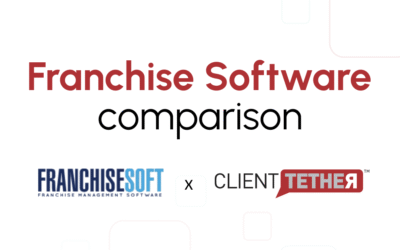Sales automation is no longer another buzzword in our Franchise vocabulary. I’d say it’s the lever separating growth-minded franchise brands from those stuck spinning their wheels. At ClientTether, we’ve seen firsthand how smart automation supercharges sales teams, unlocks serious time savings, and sparks real momentum across franchise networks.
If you’ve ever wondered what automation can really do for your bottom line, you’re in the right place. Let’s dig into what sales automation actually looks like, how to implement it like a pro, and the metrics that prove it’s working.
What You Need to know about Sales Automation
The core of sales automation is to deploy tech to take tedious, repetitive tasks off your reps’ plates. Think follow-ups, data entry, and reminders. The goal? Freeing your team up to build relationships, close deals, and grow accounts. Sales automation transforms how businesses operate, streamlining processes and increasing efficiency.
Key Tools That Make Sales Automation Happen
- Automated Email Sequences: Customized journeys that nudge leads toward a sale.
- Lead Scoring & Routing: Send your best leads to your best closers—automatically.
- Smart Chatbots: Answer questions, qualify prospects, and book meetings 24/7.
- Predictive Analytics: Know what your buyer wants before they ask.
Companies using automation see real gains in productivity and 300% growth in franchise sales. Those numbers are hard proof that automation delivers. Still skeptical? Let’s look at the main arguments against sales automation.
“It replaces my team.” Wrong. It actually amplifies your team, letting humans do human things.
“It feels cold.” Only if done poorly. With the right platform, automation is personalized.
“It’s too complex.” Not anymore. Tools like ClientTether are built to plug-and-play, no IT degree required.
Measurable Benefits for Your Business
The advantages of sales automation are substantial and quantifiable. And this often translates directly to improved revenue. According to Hubspot, sales professionals estimate they save around 2 hours and 15 minutes daily using sales automation tools to automate manual tasks such as data entry, note-taking, scheduling, and so on.
While initial setup requires some effort, the long-term time savings and efficiency gains far outweigh the upfront investment. Many automation tools (including ClientTether) are designed for user-friendliness and seamless integration with existing systems.
The Future of Sales Automation
Sales automation will likely become even more sophisticated. We can expect to see increased use of artificial intelligence and machine learning to predict customer behavior and personalize sales approaches.

Next we’ll explore how to implement these powerful sales automation strategies in your business, ensuring you maximize the benefits of this tech.
How to Implement Sales Automation Effectively
Conduct a Process Audit
The first step to implement sales automation is to conduct a thorough audit of your current sales process. Identify tasks that are repetitive, time-consuming, and don’t require complex decision-making. These tasks are prime candidates for automation.

Sales automation holds the potential to reduce the cost of sales by freeing up time spent on administration and reporting and to unlock additional revenue. Step 1: Audit your current sales flow. Where are the bottlenecks? What slows your reps down? Common candidates:
- Data entry
- Scheduling
- Follow-ups
- Lead tracking
Step 2: Choose your weapons wisely. Look for tools that offer:
- Native CRM integration
- Workflow builders
- Reporting & analytics
- User-friendly setup
Spoiler alert: ClientTether checks every box. And we built it with franchisors in mind.
Step 3: Sync it all with your CRM. Nothing breaks automation faster than disconnected systems. Make sure your automation engine talks to your CRM in real-time. This integration ensures a smooth flow of data and prevents information silos. Ensure data fields match between systems, with automatic data syncing and workflows that span across them.
Step 4: Personalize the machine with the data in your CRM to create targeted, personalized communications. Use merge fields, behavioral triggers, and audience segments . Think “mass communication, tailored messaging.”
Step 5: Test. Tweak. Repeat. A/B test email content. Track your lead scores. See what actually works and optimize on the fly.
Select the Right Tools
The selection of appropriate automation tools is critical for success. Look for solutions that integrate seamlessly with your existing tech stack and offer the specific features you need. Key features to consider:
- Email automation
- Lead scoring and routing
- CRM integration
- Analytics and reporting
- Customization options
While many options exist, ClientTether stands out as a comprehensive solution that covers all these bases and more. The platform is specifically designed to boost efficiency and automate engagement, leading to improved lead conversion rates.
The goal of sales automation is to enhance, not replace, human efforts. Automation of routine tasks frees up your sales team to focus on what they do best: building relationships and closing deals.
Now that you understand how to implement sales automation effectively, let’s explore how to measure its impact on your business. The next chapter will discuss key performance indicators and tools to monitor the effectiveness of your automation efforts.
The Metrics That Matter Most for Sales Automation
Want proof your automation is working? To gauge the effectiveness of your automation efforts, these metrics will provide insights into the impact of automation on your sales process:
Lead Response Time
This metric directly affects conversion rates. On average, it takes B2B sales teams 42 hours to respond to a new lead and 38% of those leads never reply back.
Conversion Rate
Monitor how automation impacts your lead-to-customer conversion rate. Automated emails have an open rate 70.4% higher than non-automated email newsletters. Over half of companies increased their conversion rates after adopting automation.
Sales Cycle Length
Automation should reduce your sales cycle. Measure the time from initial contact to closed deal before and after implementation.
Customer Acquisition Cost (CAC)
Calculate this by dividing total sales and marketing costs by the number of new customers acquired. Automation should lower this cost by increasing efficiency. Revenue Per Sales Rep This metric helps you assess overall sales productivity. High-performing sales teams are 3.5 times more likely to use sales analytics.
Pro Tip: Set benchmarks before and after implementation. You need that delta to measure ROI.

Tools for Monitoring Automation Effectiveness
To track KPIs effectively, you need robust analytics tools. Consider these options:
- Google Analytics:
Tracks website interactions and conversion paths. - Salesforce Einstein Analytics:
Offers AI-powered insights for sales forecasting and performance tracking. - Tableau:
Provides powerful data visualization capabilities for complex sales data. - Mixpanel:
Specializes in user behavior analytics, useful for understanding how leads interact with your automated touchpoints.
Many sales automation platforms also come with built-in analytics features. The key to maximizing the benefits of sales automation lies in ongoing analysis and optimization. Try to regularly review your KPIs and adjust your strategies accordingly.
Conduct A/B tests on your automated processes to identify areas for improvement, and make sure to gather feedback from your sales team on the effectiveness of automation tools. Stay updated on new automation technologies and features that could enhance your sales process.
Higher productivity, better lead conversion rates, increased revenue
Sales automation has revolutionized business processes, allowing companies to streamline operations and increase efficiency. The benefits are undeniable. ClientTether is built for that exact playbook. We automate what slows you down, so you can focus on what speeds you up.
With features like instant lead engagement and automated personalized communications, ClientTether provides a robust suite of tools to drive success.
So if you’re done babysitting follow-up tasks and ready to scale smarter, not harder, give us a shout. Let’s automate your growth and help you win more deals.




